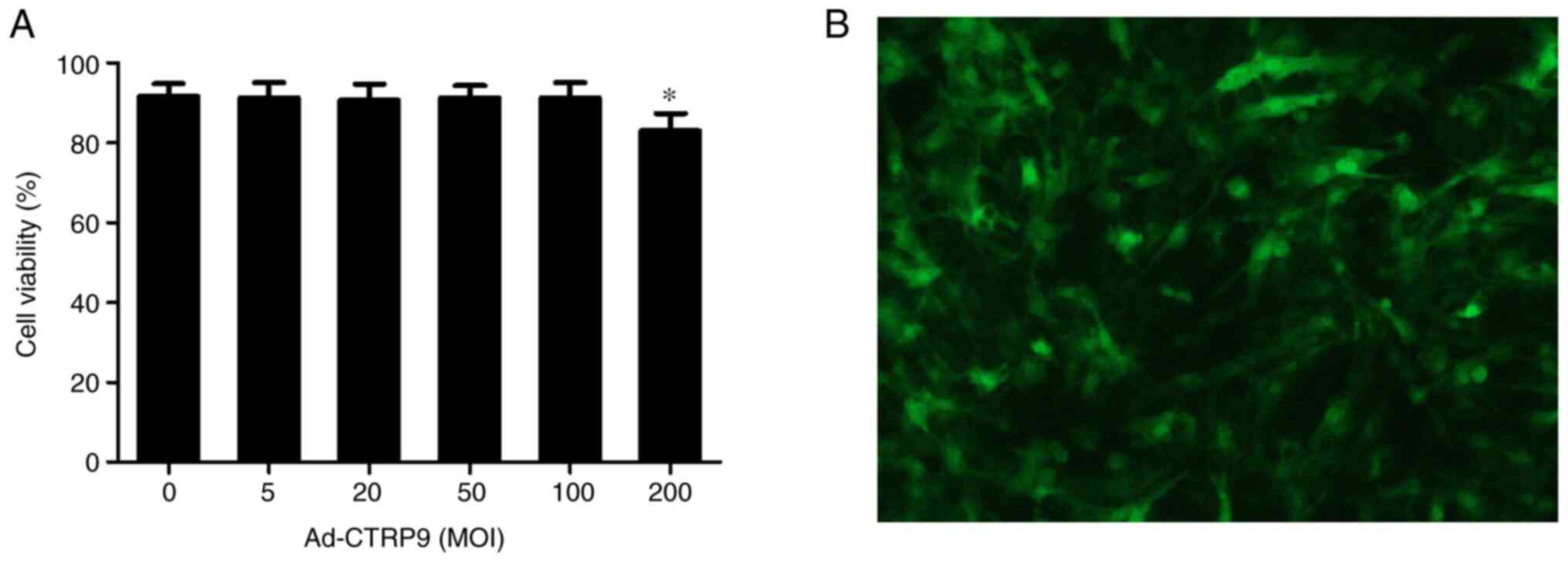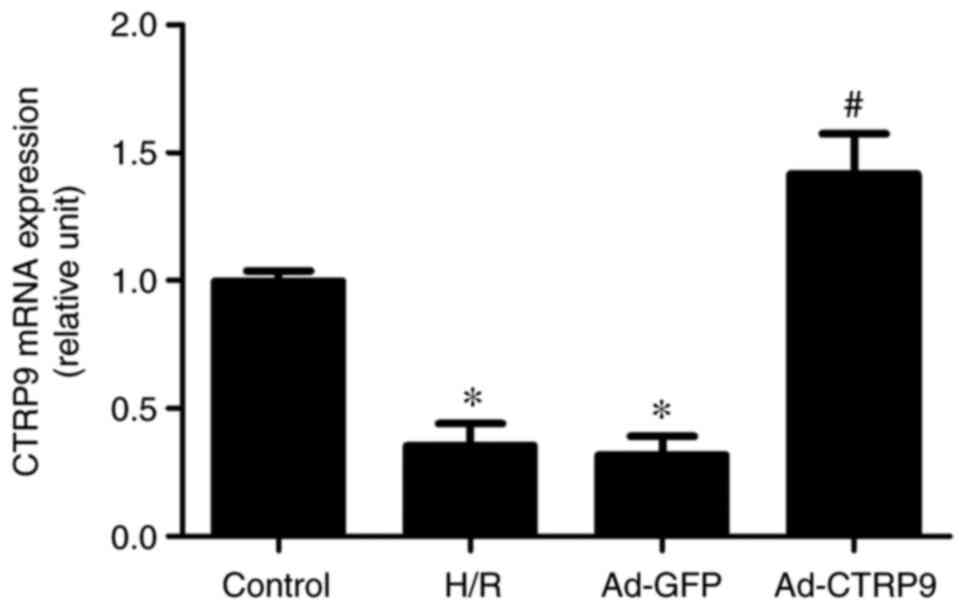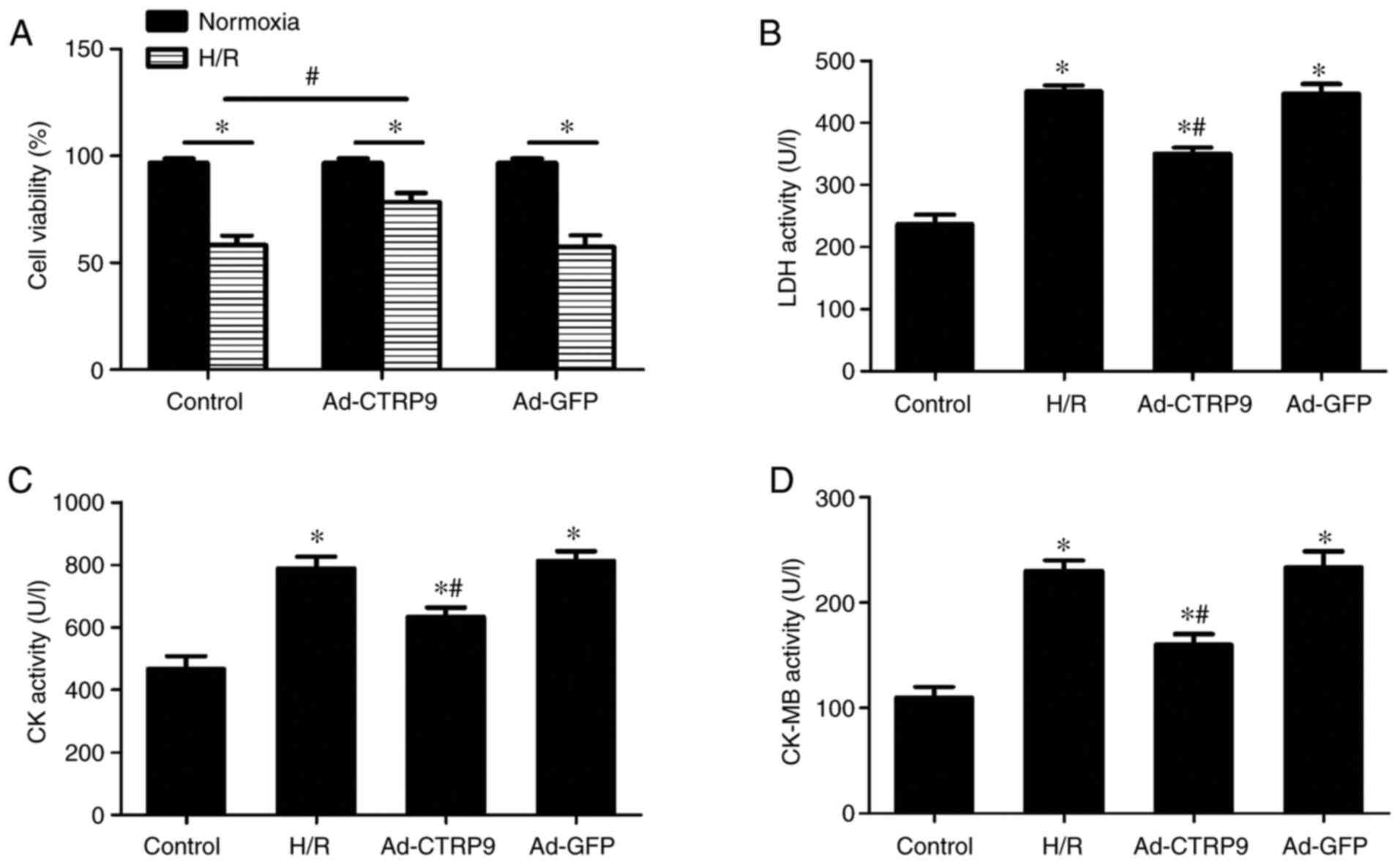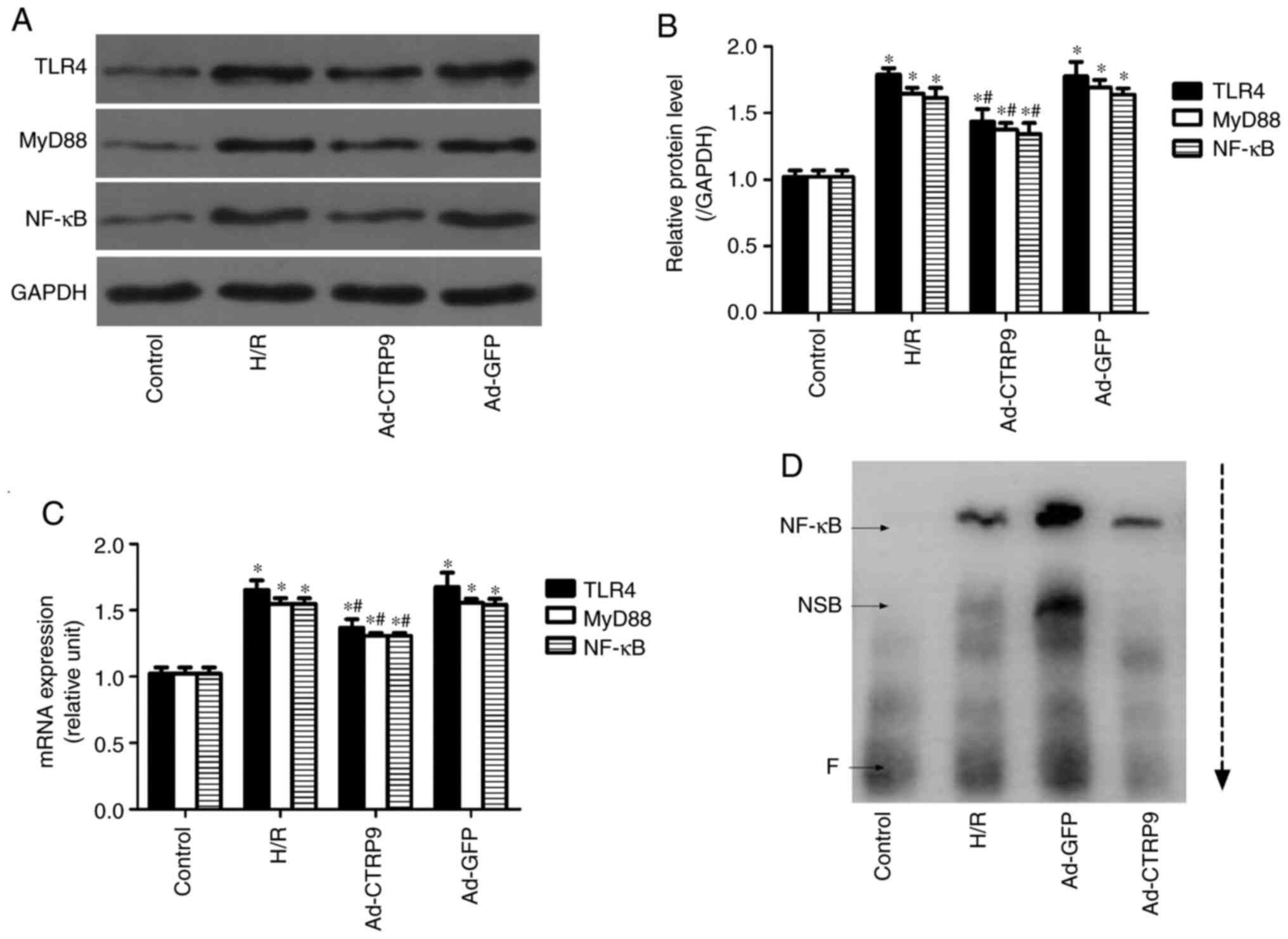|
1
|
Peng H and Abdel-Latif A: Cellular therapy
for ischemic heart disease: An update. Adv Exp Med Biol.
1201:195–213. 2019.PubMed/NCBI View Article : Google Scholar
|
|
2
|
Anderson JL and Morrow DA: Acute
myocardial infarction. N Engl J Med. 376:2053–2064. 2017.PubMed/NCBI View Article : Google Scholar
|
|
3
|
Godoy LC, Lawler PR, Farkouh ME, Hersen B,
Nicolau JC and Rao V: Urgent revascularization strategies in
patients with diabetes mellitus and acute coronary syndrome. Can J
Cardiol. 35:993–1001. 2019.PubMed/NCBI View Article : Google Scholar
|
|
4
|
Guan BF, Dai XF, Huang QB, Zhao D, Shi JL,
Chen C, Zhu Y and Ai F: Icariside II ameliorates myocardial
ischemia and reperfusion injury by attenuating inflammation and
apoptosis through the regulation of the PI3K/AKT signaling pathway.
Mol Med Rep. 22:3151–3160. 2020.PubMed/NCBI View Article : Google Scholar
|
|
5
|
Qian X, Zhu M, Qian W and Song J: Vitamin
D attenuates myocardial ischemia-reperfusion injury by inhibiting
inflammation via suppressing the RhoA/ROCK/NF-ĸB pathway.
Biotechnol Appl Biochem. 66:850–857. 2019.PubMed/NCBI View
Article : Google Scholar
|
|
6
|
Fujita T, Watanabe H, Murata Y, Hemmi S,
Yabuki M, Fuke Y, Satomura A and Soma M: Plasma C1q/TNF-related
protein 9: A promising biomarker for diabetic renal vascular
injury. Minerva Urol Nefrol. 69:195–200. 2017.PubMed/NCBI View Article : Google Scholar
|
|
7
|
Liu Q, Zhang H, Lin J, Zhang R, Chen S,
Liu W, Sun M, Du W, Hou J and Yu B: C1q/TNF-related protein 9
inhibits the cholesterol-induced Vascular smooth muscle cell
phenotype switch and cell dysfunction by activating AMP-dependent
kinase. J Cell Mol Med. 21:2823–2836. 2017.PubMed/NCBI View Article : Google Scholar
|
|
8
|
Liu M, Li W, Wang H, Yin L, Ye B, Tang Y
and Huang C: CTRP9 ameliorates atrial inflammation, fibrosis, and
vulnerability to atrial fibrillation in post-myocardial infarction
rats. J Am Heart Assoc. 8(e013133)2019.PubMed/NCBI View Article : Google Scholar
|
|
9
|
Liu M, Yin L, Li W, Hu J, Wang H, Ye B,
Tang Y and Huang C: C1q/TNF-related protein-9 promotes macrophage
polarization and improves cardiac dysfunction after myocardial
infarction. J Cell Physiol. 234:18731–18747. 2019.PubMed/NCBI View Article : Google Scholar
|
|
10
|
Wang J, Hang T, Cheng XM, Li DM, Zhang QG,
Wang LJ, Peng YP and Gong JB: Associations of C1q/TNF-related
protein-9 levels in serum and epicardial adipose tissue with
coronary atherosclerosis in humans. Biomed Res Int.
2015(971683)2015.PubMed/NCBI View Article : Google Scholar
|
|
11
|
Gao C, Zhao S, Lian K, Mi B, Si R, Tan Z,
Fu F, Wang S, Wang R, Ma X and Tao L: C1q/TNF-related protein 3
(CTRP3) and 9 (CTRP9) concentrations are decreased in patients with
heart failure and are associated with increased morbidity and
mortality. BMC Cardiovasc Disord. 19(139)2019.PubMed/NCBI View Article : Google Scholar
|
|
12
|
Kambara T, Ohashi K, Shibata R, Ogura Y,
Maruyama S, Enomoto T, Uemura Y, Shimizu Y, Yuasa D, Matsuo K, et
al: CTRP9 protein protects against myocardial injury following
ischemia-reperfusion through AMP-activated protein kinase
(AMPK)-dependent mechanism. J Biol Chem. 287:18965–18973.
2012.PubMed/NCBI View Article : Google Scholar
|
|
13
|
Zhao D, Feng P, Sun Y, Qin Z, Zhang Z, Tan
Y, Gao E, Lau WB, Ma X, Yang J, et al: Cardiac-derived CTRP9
protects against myocardial ischemia/reperfusion injury via
calreticulin-dependent inhibition of apoptosis. Cell Death Dis.
9(723)2018.PubMed/NCBI View Article : Google Scholar
|
|
14
|
Zhang J, Zhang J, Yu P, Chen M, Peng Q,
Wang Z and Dong N: Remote ischaemic preconditioning and sevoflurane
postconditioning synergistically protect rats from myocardial
injury induced by ischemia and reperfusion partly via inhibition
TLR4/MyD88/NF-κB signaling pathway. Cell Physiol Biochem. 41:22–32.
2017.PubMed/NCBI View Article : Google Scholar
|
|
15
|
Ye B, Chen X, Dai S, Han J, Liang X, Lin
S, Cai X, Huang Z and Huang W: Emodin alleviates myocardial
ischemia/reperfusion injury by inhibiting gasdermin D-mediated
pyroptosis in cardiomyocytes. Drug Des Devel Ther. 13:975–990.
2019.PubMed/NCBI View Article : Google Scholar
|
|
16
|
Xue J, Ge H, Lin Z, Wang H, Lin W, Liu Y,
Wu G, Xia J and Zhao Q: The role of dendritic cells regulated by
HMGB1/TLR4 signalling pathway in myocardial ischaemia reperfusion
injury. J Cell Mol Med. 23:2849–2862. 2019.PubMed/NCBI View Article : Google Scholar
|
|
17
|
Li X, Yang J, Yang J, Dong W, Li S, Wu H
and Li L: RP105 protects against myocardial ischemia-reperfusion
injury via suppressing TLR4 signaling pathways in rat model. Exp
Mol Pathol. 100:281–286. 2016.PubMed/NCBI View Article : Google Scholar
|
|
18
|
Simpson P, McGrath A and Savion S: Myocyte
hypertrophy in neonatal rat heart cultures and its regulation by
serum and by catecholamines. Circ Res. 51:787–801. 1982.PubMed/NCBI View Article : Google Scholar
|
|
19
|
Hnasko TS and Hnasko RM: The western blot.
Methods Mol Biol. 1318:87–96. 2015.PubMed/NCBI View Article : Google Scholar
|
|
20
|
Livak KJ and Schmittgen TD: Analysis of
relative gene expression data using real-time quantitative PCR and
the 2(-Delta Delta C(T)) method. Methods. 25:402–408.
2001.PubMed/NCBI View Article : Google Scholar
|
|
21
|
Xu W, Zhang K, Zhang Y, Ma S and Jin D:
Downregulation of DEC1 by RNA interference attenuates
ischemia/reperfusion-induced myocardial inflammation by inhibiting
the TLR4/NF-κB signaling pathway. Exp Ther Med. 20:343–350.
2020.PubMed/NCBI View Article : Google Scholar
|
|
22
|
Zhang R, Xu L, Zhang D, Hu B, Luo Q, Han
D, Li J and Shen C: Cardioprotection of ginkgolide B on myocardial
ischemia/reperfusion-induced inflammatory injury via regulation of
A20-NF-κB pathway. Front Immunol. 9(2844)2018.PubMed/NCBI View Article : Google Scholar
|
|
23
|
Yan W, Guo Y, Tao L, Lau WB, Gan L, Yan Z,
Guo R, Gao E, Wong GW, Koch WL, et al: C1q/tumor necrosis
factor-related protein-9 regulates the fate of implanted
mesenchymal stem cells and mobilizes their protective effects
against ischemic heart injury via multiple novel signaling
pathways. Circulation. 136:2162–2177. 2017.PubMed/NCBI View Article : Google Scholar
|
|
24
|
Sun Y, Yi W, Yuan Y, Lau WB, Yi D, Wang X,
Wang Y, Su H, Wang X, Gao E, et al: C1q/tumor necrosis
factor-related protein-9, a novel adipocyte-derived cytokine,
attenuates adverse remodeling in the ischemic mouse heart via
protein kinase A activation. Circulation. 128 (11 Suppl
1):S113–S120. 2013.PubMed/NCBI View Article : Google Scholar
|
|
25
|
Weng CF, Wu CF, Kao SH, Chen JC and Lin
HH: Down-regulation of miR-34a-5p potentiates protective effect of
adipose-derived mesenchymal stem cells against ischemic myocardial
infarction by stimulating the expression of C1q/tumor necrosis
factor-related protein-9. Front Physiol. 10(1445)2019.PubMed/NCBI View Article : Google Scholar
|
|
26
|
Bai S, Cheng L, Yang Y, Fan C, Zhao D, Qin
Z, Feng X, Zhao L, Ma J, Wang X, et al: C1q/TNF-related protein 9
protects diabetic rat heart against ischemia reperfusion injury:
Role of endoplasmic reticulum stress. Oxid Med Cell Longev.
2016(1902025)2016.PubMed/NCBI View Article : Google Scholar
|
|
27
|
Li Y, Geng X, Wang H, Cheng G and Xu S:
CTRP9 ameliorates pulmonary arterial hypertension through
attenuating inflammation and improving endothelial cell survival
and function. J Cardiovasc Pharmacol. 67:394–401. 2016.PubMed/NCBI View Article : Google Scholar
|
|
28
|
Liu T, Xu B and Liu Z: CTRP9 alleviates
inflammation to ameliorate myocardial infarction in rats by
activating Nrf2. Minerva Endocrinol. 45:268–270. 2020.PubMed/NCBI View Article : Google Scholar
|
|
29
|
Jung CH, Lee MJ, Kang YM, Lee YL, Seol SM,
Yoon HK, Kang SW, Lee WJ and Park JY: C1q/TNF-related protein-9
inhibits cytokine-induced vascular inflammation and leukocyte
adhesiveness via AMP-activated protein kinase activation in
endothelial cells. Mol Cell Endocrinol. 419:235–243.
2016.PubMed/NCBI View Article : Google Scholar
|
|
30
|
Li W, Ma N, Liu MX, Ye BJ, Li YJ, Hu HY
and Tang YH: C1q/TNF-related protein-9 attenuates retinal
inflammation and protects blood-retinal barrier in db/db mice. Eur
J Pharmacol. 853:289–298. 2019.PubMed/NCBI View Article : Google Scholar
|
|
31
|
Zhang H, Gong X, Ni S, Wang Y, Zhu L and
Ji N: C1q/TNF-related protein-9 attenuates atherosclerosis through
AMPK-NLRP3 inflammasome singling pathway. Int Immunopharmacol.
77(105934)2019.PubMed/NCBI View Article : Google Scholar
|
|
32
|
Qian M, Yang Q, Li J, Zhao B, Zhang Y and
Zhao Y: C1q/TNF-related protein-9 alleviates airway inflammation in
asthma. Int Immunopharmacol. 81(106238)2020.PubMed/NCBI View Article : Google Scholar
|
|
33
|
Zhao L, Chen S, Sherchan P, Ding Y, Zhao
W, Guo Z, Yu J, Tang J and Zhang JH: Recombinant CTRP9
administration attenuates neuroinflammation via activating
adiponectin receptor 1 after intracerebral hemorrhage in mice. J
Neuroinflammation. 15(215)2018.PubMed/NCBI View Article : Google Scholar
|
|
34
|
Azam S, Jakaria M, Kim IS, Kim J, Haque ME
and Choi DK: Regulation of toll-like receptor (TLR) signaling
pathway by polyphenols in the treatment of age-linked
neurodegenerative diseases: Focus on TLR4 signaling. Front Immunol.
10(1000)2019.PubMed/NCBI View Article : Google Scholar
|
|
35
|
Ju M, Liu B, He H, Gu Z, Liu Y, Su Y, Zhu
D, Cang J and Luo Z: MicroRNA-27a alleviates LPS-induced acute lung
injury in mice via inhibiting inflammation and apoptosis through
modulating TLR4/MyD88/NF-κB pathway. Cell Cycle. 17:2001–2018.
2018.PubMed/NCBI View Article : Google Scholar
|
|
36
|
Zheng Z, Zeng YZ, Ren K, Zhu X, Tan Y, Li
Y, Li Q and Yi GH: S1P promotes inflammation-induced tube formation
by HLECs via the S1PR1/NF-κB pathway. Int Immunopharmacol.
66:224–235. 2019.PubMed/NCBI View Article : Google Scholar
|
|
37
|
Yuan X, Juan Z, Zhang R, Sun X, Yan R, Yue
F, Huang Y, Yu J and Xia X: Clemastine fumarate protects against
myocardial ischemia reperfusion injury by activating the
TLR4/PI3K/Akt signaling pathway. Front Pharmacol.
11(28)2020.PubMed/NCBI View Article : Google Scholar
|
|
38
|
Guo X, Jiang H, Yang J, Chen J, Yang J,
Ding JW, Li S, Wu H and Ding HS: Radioprotective 105 kDa protein
attenuates ischemia/reperfusion-induced myocardial apoptosis and
autophagy by inhibiting the activation of the TLR4/NF-κB signaling
pathway in rats. Int J Mol Med. 38:885–893. 2016.PubMed/NCBI View Article : Google Scholar
|
|
39
|
Appari M, Breitbart A, Brandes F,
Szaroszyk M, Froese N, Korf-Klingebiel M, Mohammadi MM, Grund A,
Scharf GM, Wang H, et al: C1q-TNF-related protein-9 promotes
cardiac hypertrophy and failure. Circ Res. 120:66–77.
2017.PubMed/NCBI View Article : Google Scholar
|
|
40
|
Zheng S, Ren J, Gong S, Qiao F and He J:
CTRP9 protects against MIA-induced inflammation and knee cartilage
damage by deactivating the MAPK/NF-κB pathway in rats with
osteoarthritis. Open Life Sci. 15:971–980. 2020.PubMed/NCBI View Article : Google Scholar
|



















